Towards an Ideal Energy Absorber: Relating Failure Mechanisms and Energy Absorption Metrics in Additively Manufactured AlSi10Mg Cellular Structures under Quasistatic Compression
Abstract
1. Introduction
2. Design and Manufacturing
2.1. Rationale for Unit Cell Selection
2.2. Manufacturing
2.3. Compression Test Setup
3. Results
3.1. Effect of Unit Cell Shape
3.1.1. Hexagonal Honeycomb
3.1.2. Auxetic Lattice
3.1.3. Voronoi (Stochastic) Lattice
3.1.4. Schwarz-P TPMS
3.1.5. Diamond TPMS
3.1.6. Gyroid TPMS
3.2. Effect of Tube Enclosure
4. Discussion: Towards an Ideal Energy Absorber
4.1. Specific Energy Absorption and Transmitted Stress
4.2. Densification Efficiency
4.3. Plateau Undulation
4.4. Tunability
4.5. Evaluating Overall Energy Absorption Performance
5. Conclusions
- The 20 µm layer thickness laser powder bed fusion process on a 100 W laser machine generates lattices, honeycombs and TPMS cellular structures with high fidelity as evidenced by microscopy and the agreement between measured and nominally designed relative densities.
- A combination of four criteria may be used in determining the overall appropriateness of a cellular structure for implementation into energy absorbing system: (i) SEA vs. maximum transmitted stress; (ii) densification efficiency; (iii) plateau undulation; and (iv) tunability.
- Auxetic and Voronoi lattice structures perform poorly as energy absorbers primarily due to low SEA relative to maximum transmitted stresses, and low densification efficiencies. Lattices are however highly tunable.
- TPMS structures, in particular the diamond and gyroid shapes, show great promise as energy absorption materials, relative to honeycombs. This is primarily on account of their more gradual failure mechanism that includes folding and stacking of cell walls above each other, resulting in higher densification densities and lower plateau undulations.
- Enclosing cellular structures in tubes has the effect of increasing peak stress while also increasing plateau stress undulations.
Supplementary Materials
Author Contributions
Funding
Data Availability Statement
Acknowledgments
Conflicts of Interest
References
- Yin, S.; Li, J.; Liu, B.; Meng, K.; Huan, Y.; Nutt, S.R.; Xu, J. Honeytubes: Hollow lattice truss reinforced honeycombs for crushing protection. Compos. Struct. 2017, 160, 1147–1154. [Google Scholar] [CrossRef]
- Harris, J.A.; Winter, R.E.; McShane, G.J. Impact response of additively manufactured metallic hybrid lattice materials. Int. J. Impact Eng. 2017, 104, 177–191. [Google Scholar] [CrossRef]
- Sun, G.; Jiang, H.; Fang, J.; Li, G.; Li, Q. Crashworthiness of vertex based hierarchical honeycombs in out-of-plane impact. Mater. Des. 2016, 110, 705–719. [Google Scholar] [CrossRef]
- Ha, N.S.; Lu, G.; Xiang, X. Energy absorption of a bio-inspired honeycomb sandwich panel. J. Mater. Sci. 2019, 54, 6286–6300. [Google Scholar] [CrossRef]
- Alantali, A.; Alia, R.A.; Umer, R.; Cantwell, W.J. Energy absorption in aluminium honeycomb cores reinforced with carbon fibre reinforced plastic tubes. J. Sandw. Struct. Mater. 2019, 21, 2801–2815. [Google Scholar] [CrossRef]
- Sun, Y.; Li, Q.M. Dynamic compressive behaviour of cellular materials: A review of phenomenon, mechanism and modelling. Int. J. Impact Eng. 2018, 112, 74–115. [Google Scholar] [CrossRef]
- Branch, B.; Ionita, A.; Patterson, B.M.; Schmalzer, A.; Clements, B.; Mueller, A.; Dattelbaum, D.M. A comparison of shockwave dynamics in stochastic and periodic porous polymer architectures. Polymer 2019, 160, 325–337. [Google Scholar] [CrossRef]
- Rakow, J.F.; Waas, A.M. Size effects and the shear response of aluminum foam. Mech. Mater. 2005, 37, 69–82. [Google Scholar] [CrossRef]
- Chen, B.C.; Zou, M.; Liu, G.M.; Song, J.F.; Wang, H.X. Experimental study on energy absorption of bionic tubes inspired by bamboo structures under axial crushing. Int. J. Impact Eng. 2018, 115, 48–57. [Google Scholar] [CrossRef]
- Tang, Z.; Liu, S.; Zhang, Z. Analysis of energy absorption characteristics of cylindrical multi-cell columns. Thin-Walled Struct. 2013, 62, 75–84. [Google Scholar] [CrossRef]
- Yang, K.; Xu, S.; Zhou, S.; Shen, J.; Xie, Y.M. Design of dimpled tubular structures for energy absorption. Thin-Walled Struct. 2017, 112, 31–40. [Google Scholar] [CrossRef]
- Xiang, Y.; Wang, M.; Yu, T.; Yang, L. Key Performance Indicators of Tubes and Foam-Filled Tubes Used as Energy Absorbers. Int. J. Appl. Mech. 2015, 7, 1550060. [Google Scholar] [CrossRef]
- Wu, F.; Xiao, X.; Yang, J.; Gao, X. Quasi-static axial crushing behaviour and energy absorption of novel metal rope crochet-sintered mesh tubes. Thin-Walled Struct. 2018, 127, 120–134. [Google Scholar] [CrossRef]
- Gibson, L.; Ashby, M. Cellular Solids: Structure and Properties, 2nd ed.; Cambridge University Press: Cambridge, UK, 1999. [Google Scholar]
- Ashby, M.F.; Evans, A.G.; Fleck, N.A.; Gibson, L.J.; Hutchinson, J.W.; Wadley, H.N.G. Metal Foams: A Design Guide; Butterworth Heinemann: Oxford, UK, 2010. [Google Scholar]
- Bhate, D.; Penick, C.A.; Ferry, L.A.; Lee, C. Classification and selection of cellular materials in mechanical design: Engineering and biomimetic approaches. Designs 2019, 3, 19. [Google Scholar] [CrossRef]
- Gümrük, R.; Mines, R.A.W. Compressive behaviour of stainless steel micro-lattice structures. Int. J. Mech. Sci. 2013, 68, 125–139. [Google Scholar] [CrossRef]
- Maskery, I.; Aboulkhair, N.T.; Aremu, A.O.; Tuck, C.J.; Ashcroft, I.A.; Wildman, R.D.; Hague, R.J.M. A mechanical property evaluation of graded density Al-Si10-Mg lattice structures manufactured by selective laser melting. Mater. Sci. Eng. A 2016, 670, 264–274. [Google Scholar] [CrossRef]
- Ozdemir, Z.; Hernandez-Nava, E.; Tyas, A.; Warren, J.A.; Fay, S.D.; Goodall, R.; Todd, I.; Askes, H. Energy absorption in lattice structures in dynamics: Experiments. Int. J. Impact Eng. 2016, 89, 49–61. [Google Scholar] [CrossRef]
- Hazeli, K.; Babamiri, B.B.; Indeck, J.; Minor, A.; Askari, H. Microstructure-topology relationship effects on the quasi-static and dynamic behavior of additively manufactured lattice structures. Mater. Des. 2019, 176, 107826. [Google Scholar] [CrossRef]
- McKown, S.; Shen, Y.; Brookes, W.K.; Sutcliffe, C.J.; Cantwell, W.J.; Langdon, G.S.; Nurick, G.N.; Theobald, M.D. The quasi-static and blast loading response of lattice structures. Int. J. Impact Eng. 2008, 35, 795–810. [Google Scholar] [CrossRef]
- Liu, X.; Suzuki, A.; Takata, N.; Kobashi, M.; Kato, M. Dual plateau stress of C15-type topologically close-packed lattice structures additive-manufactured by laser powder bed fusion. Scr. Mater. 2021, 202, 114003. [Google Scholar] [CrossRef]
- Liu, Y.; Schaedler, T.A.; Jacobsen, A.J.; Chen, X. Quasi-static energy absorption of hollow microlattice structures. Compos. Part B Eng. 2014, 67, 39–49. [Google Scholar] [CrossRef]
- Schaedler, T.A.; Ro, C.J.; Sorensen, A.E.; Eckel, Z.; Yang, S.S.; Carter, W.B.; Jacobsen, A.J. Designing Metallic Microlattices for Energy Absorber Applications. Adv. Eng. Mater. 2014, 16, 276–283. [Google Scholar] [CrossRef]
- Maskery, I.; Aboulkhair, N.T.; Aremu, A.O.; Tuck, C.J.; Ashcroft, I.A. Compressive failure modes and energy absorption in additively manufactured double gyroid lattices. Addit. Manuf. 2017, 16, 24–29. [Google Scholar] [CrossRef]
- Yan, C.; Hao, L.; Hussein, A.; Bubb, S.L.; Young, P.; Raymont, D. Evaluation of light-weight AlSi10Mg periodic cellular lattice structures fabricated via direct metal laser sintering. J. Mater. Process. Technol. 2014, 214, 856–864. [Google Scholar] [CrossRef]
- Ma, Z.; Zhang, D.Z.; Liu, F.; Jiang, J.; Zhao, M.; Zhang, T. Lattice structures of Cu-Cr-Zr copper alloy by selective laser melting: Microstructures, mechanical properties and energy absorption. Mater. Des. 2020, 187, 108406. [Google Scholar] [CrossRef]
- Liang, Y.; Zhou, W.; Liu, Y.; Li, Z.; Yang, Y.; Xi, H.; Wu, Z. Energy Absorption and Deformation Behavior of 3D Printed Triply Periodic Minimal Surface Stainless Steel Cellular Structures under Compression. Steel Res. Int. 2021, 92, 2000411. [Google Scholar] [CrossRef]
- Zhang, L.; Feih, S.; Daynes, S.; Chang, S.; Wang, M.Y.; Wei, J.; Lu, W.F. Energy absorption characteristics of metallic triply periodic minimal surface sheet structures under compressive loading. Addit. Manuf. 2018, 23, 505–515. [Google Scholar] [CrossRef]
- Harris, J.A.; McShane, G.J. Metallic stacked origami cellular materials: Additive manufacturing, properties, and modelling. Int. J. Solids Struct. 2020, 185–186, 448–466. [Google Scholar] [CrossRef]
- Du, Y.; Gu, D.; Xi, L.; Dai, D.; Gao, T.; Zhu, J.; Ma, C. Laser additive manufacturing of bio-inspired lattice structure: Forming quality, microstructure and energy absorption behavior. Mater. Sci. Eng. A 2020, 773, 138857. [Google Scholar] [CrossRef]
- Li, Q.M.; Magkiriadis, I.; Harrigan, J.J. Compressive strain at the onset of densification of cellular solids. J. Cell Plast. 2006, 42, 371–392. [Google Scholar] [CrossRef]
- Andrews, E.W.; Gioux, G.; Onck, P.; Gibson, L.J. Size effects in ductile cellular solids. Part II: Experimental results. Int. J. Mech. Sci. 2001, 43, 701–713. [Google Scholar] [CrossRef]
- Tekoglu, C.; Gibson, L.J.; Pardoen, T.; Onck, P.R. Size effects in foams: Experiments and modeling. Prog. Mater. Sci. 2011, 56, 109–138. [Google Scholar] [CrossRef]
- NTopology Platform. Available online: https://ntopology.com (accessed on 1 May 2020).
- Zhang, J.; Lu, G.; You, Z. Large deformation and energy absorption of additively manufactured auxetic materials and structures: A review. Compos. Part B 2020, 201, 108340. [Google Scholar] [CrossRef]
- ASTM F3302; Standard for Additive Manufacturing—Finished Part Properties—Standard Specification for Titanium Alloys via Powder Bed Fusion. ASTM Standards: West Conshohocken, PA, USA, 2018; Volume 10.04, pp. 1–8. [CrossRef]
- AMS2774E; IN718 Heat Treatment. SAE Standard: Warrendale, PA, USA, 2016.
- Casanova, L.; Anitha, V.V.; Kadway, N.; Gandhi, A.; Le, T.; Lee, C.; Bhate, D. On the Mechanical Behavior of Additively Manufactured Asymmetric Honeycombs. In Proceedings of the 2018 International Solid Freeform Fabrication Symposium, Austin, TX, USA, 13–15 August 2018. [Google Scholar]
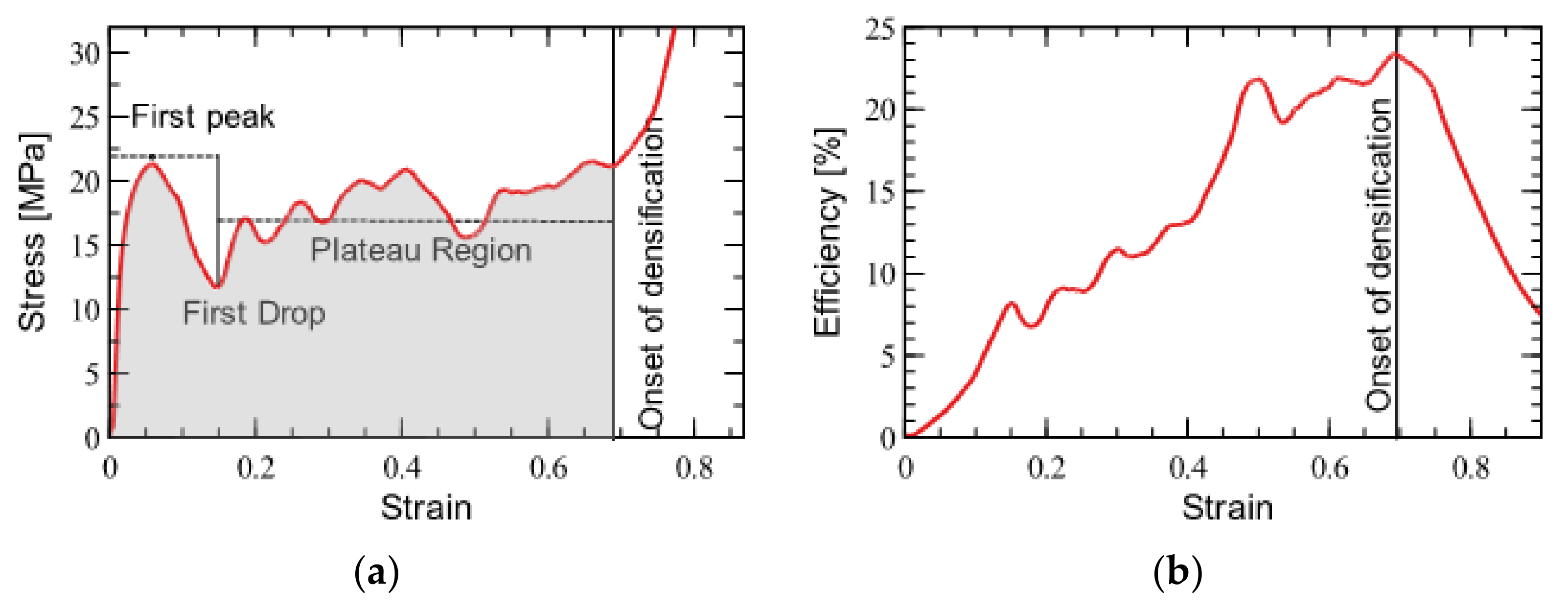


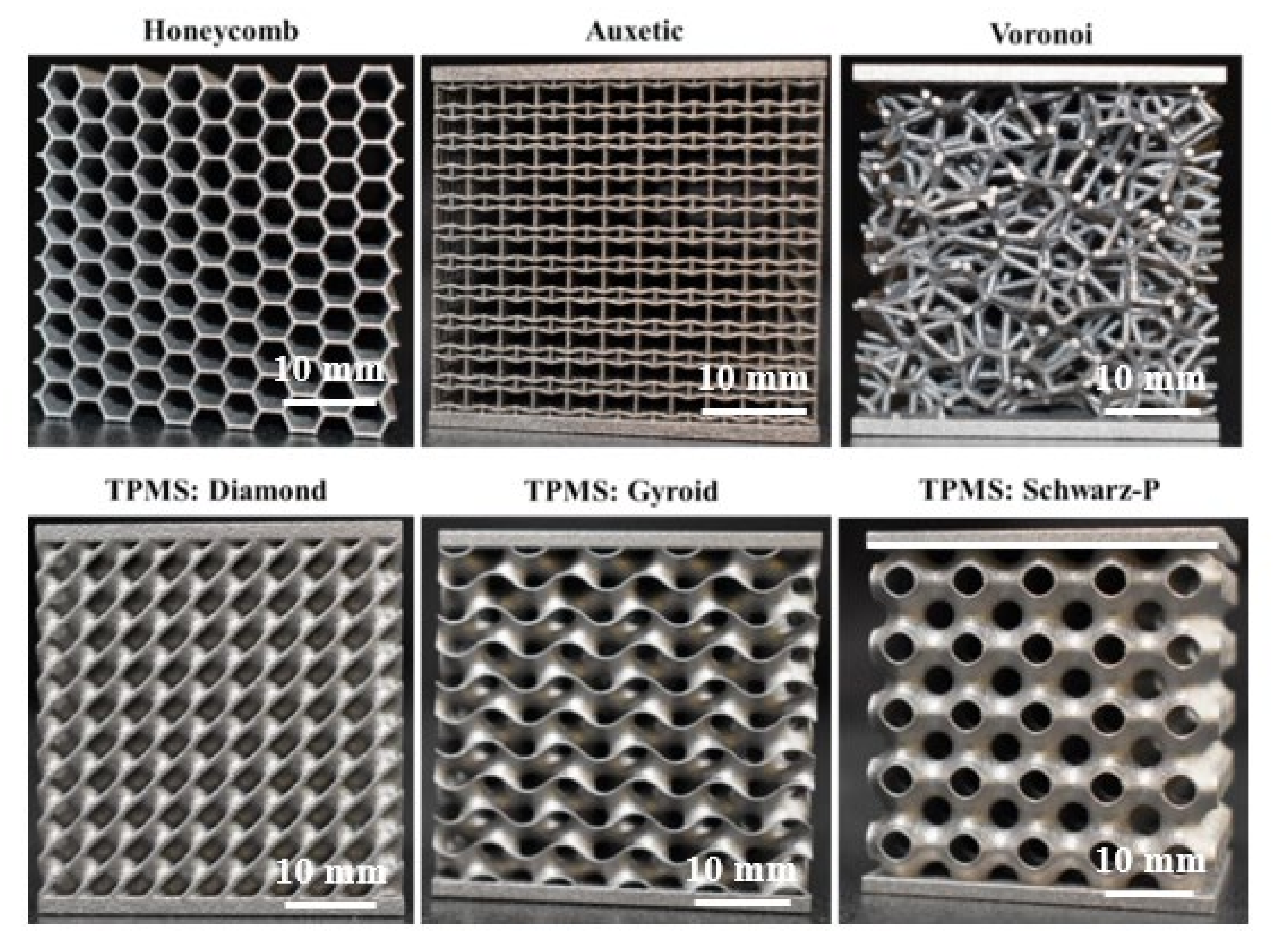
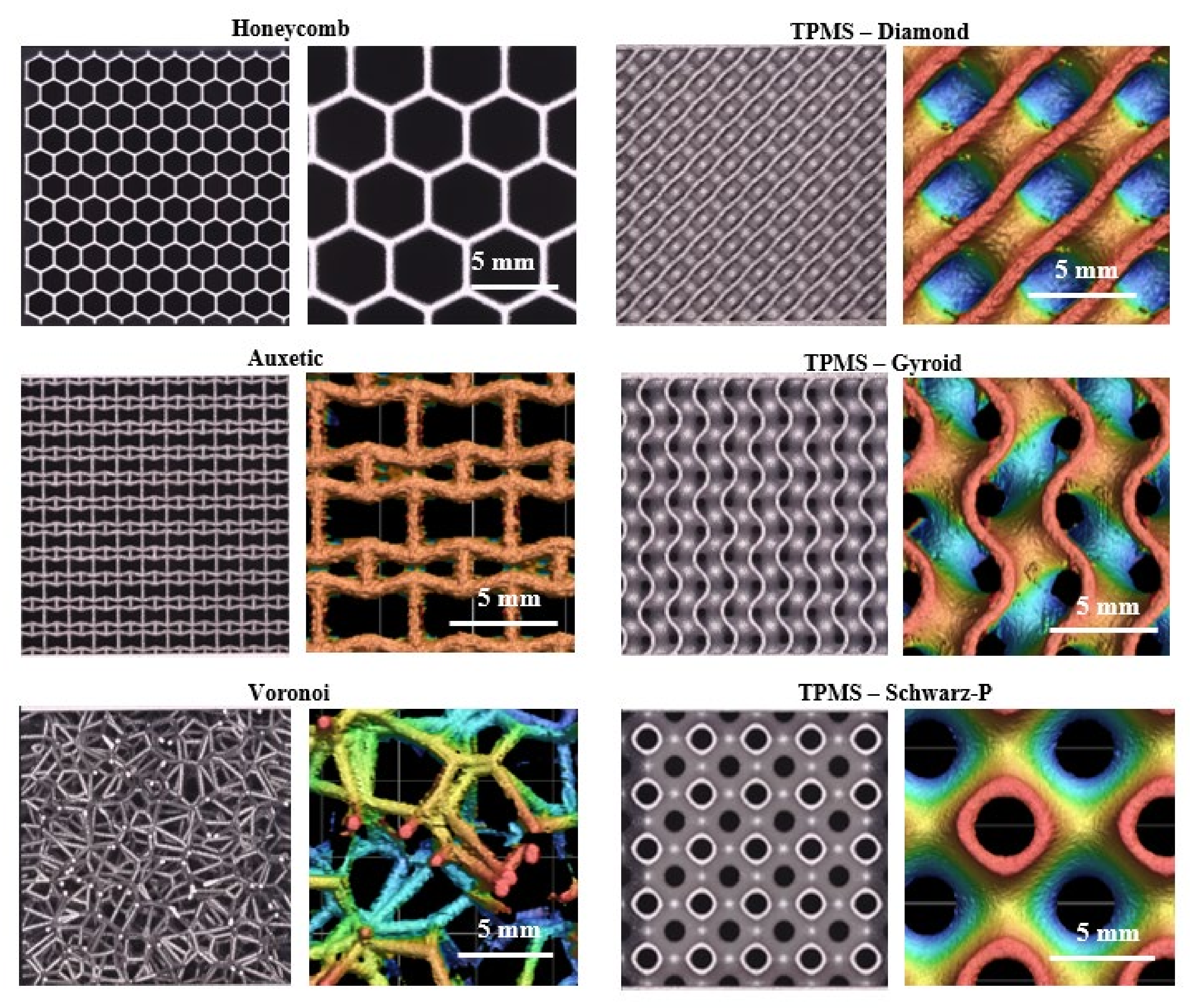
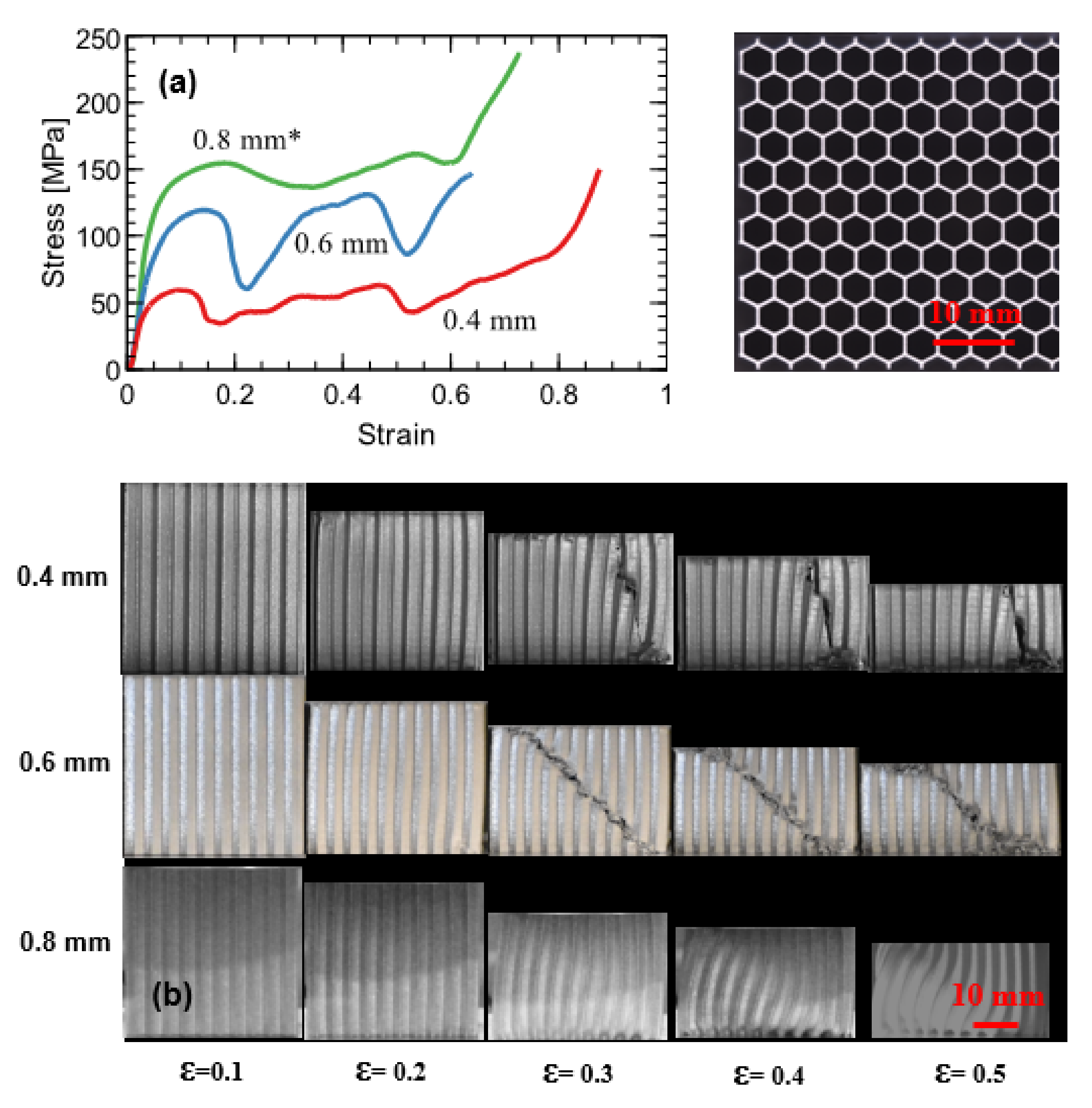

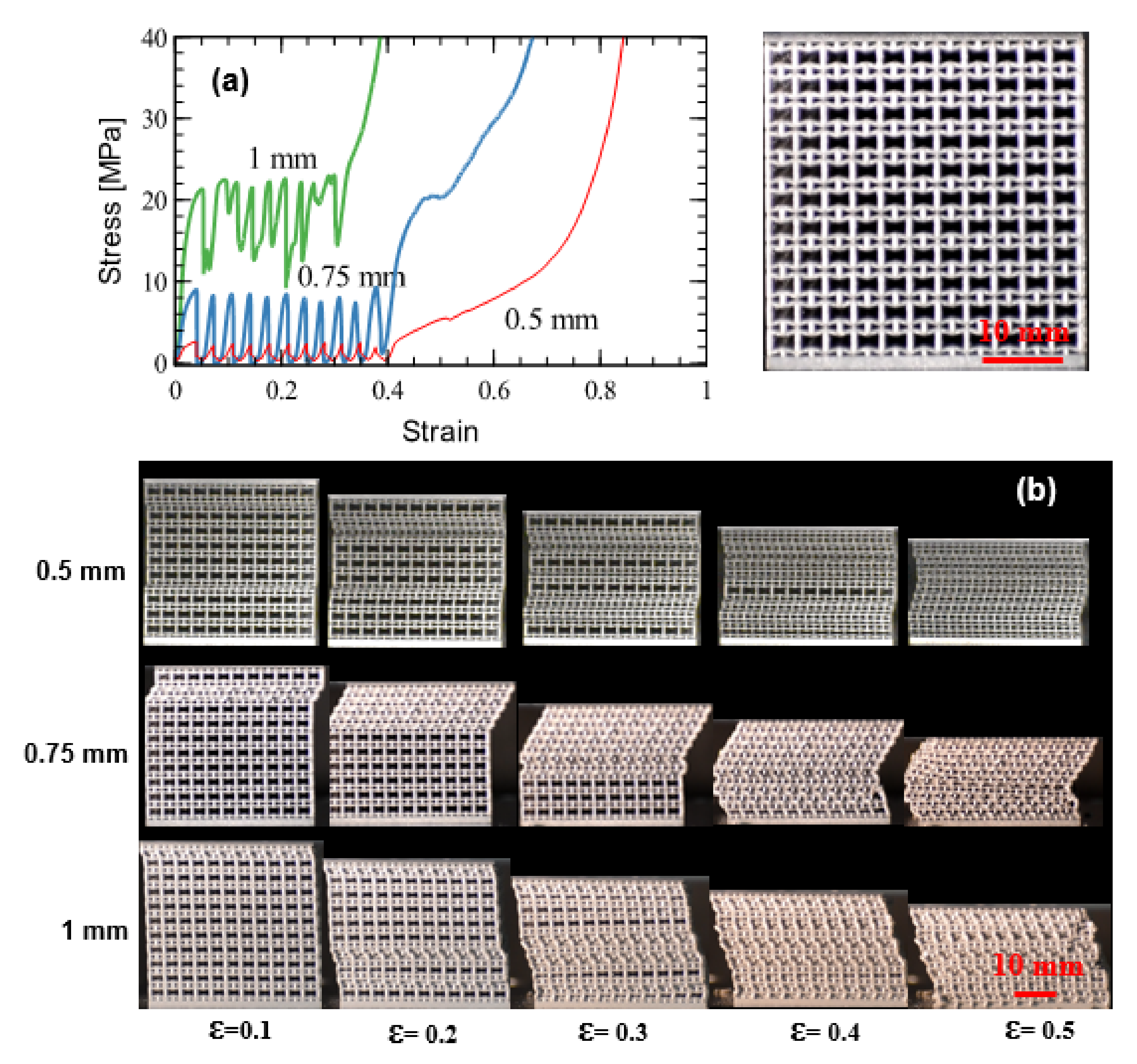
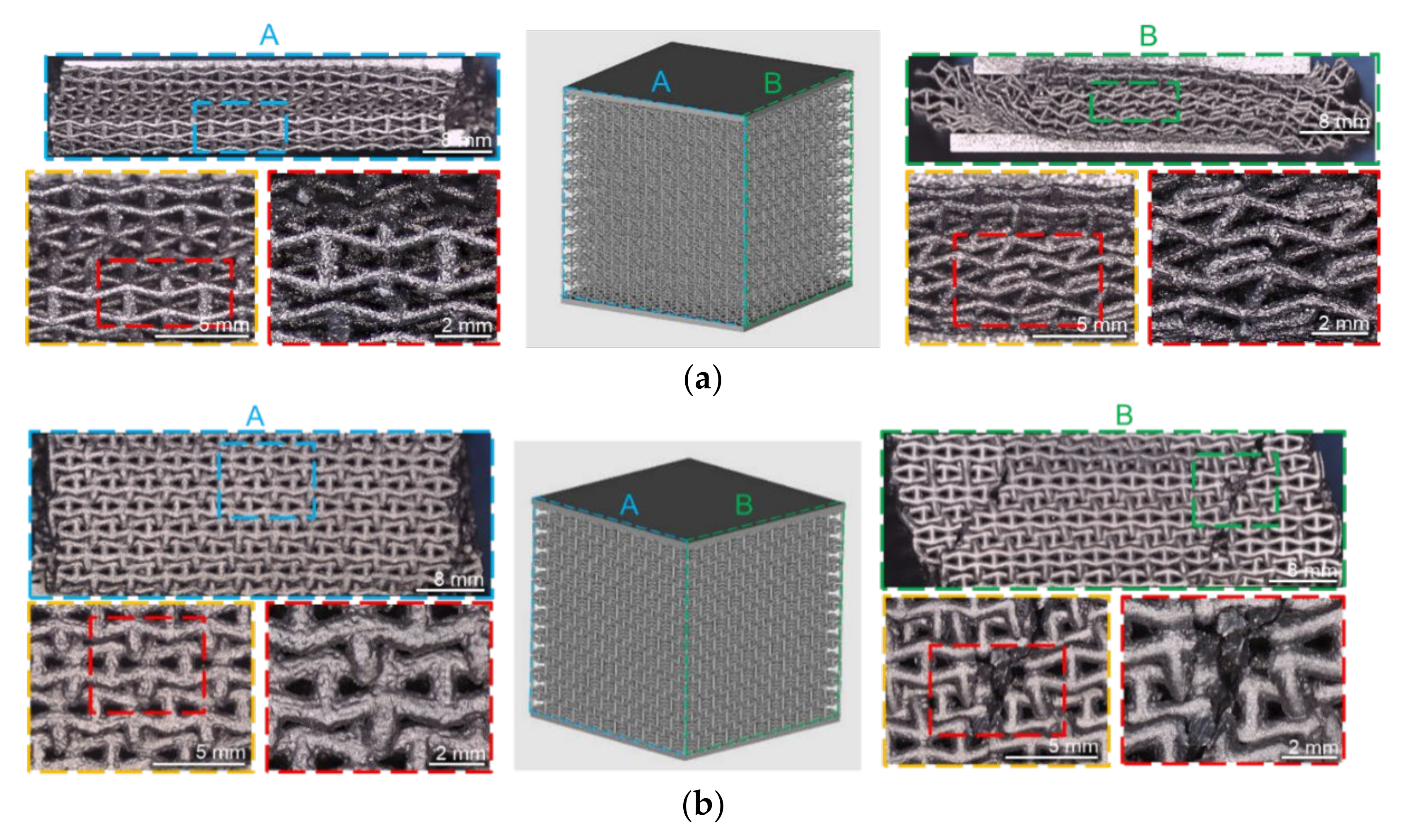
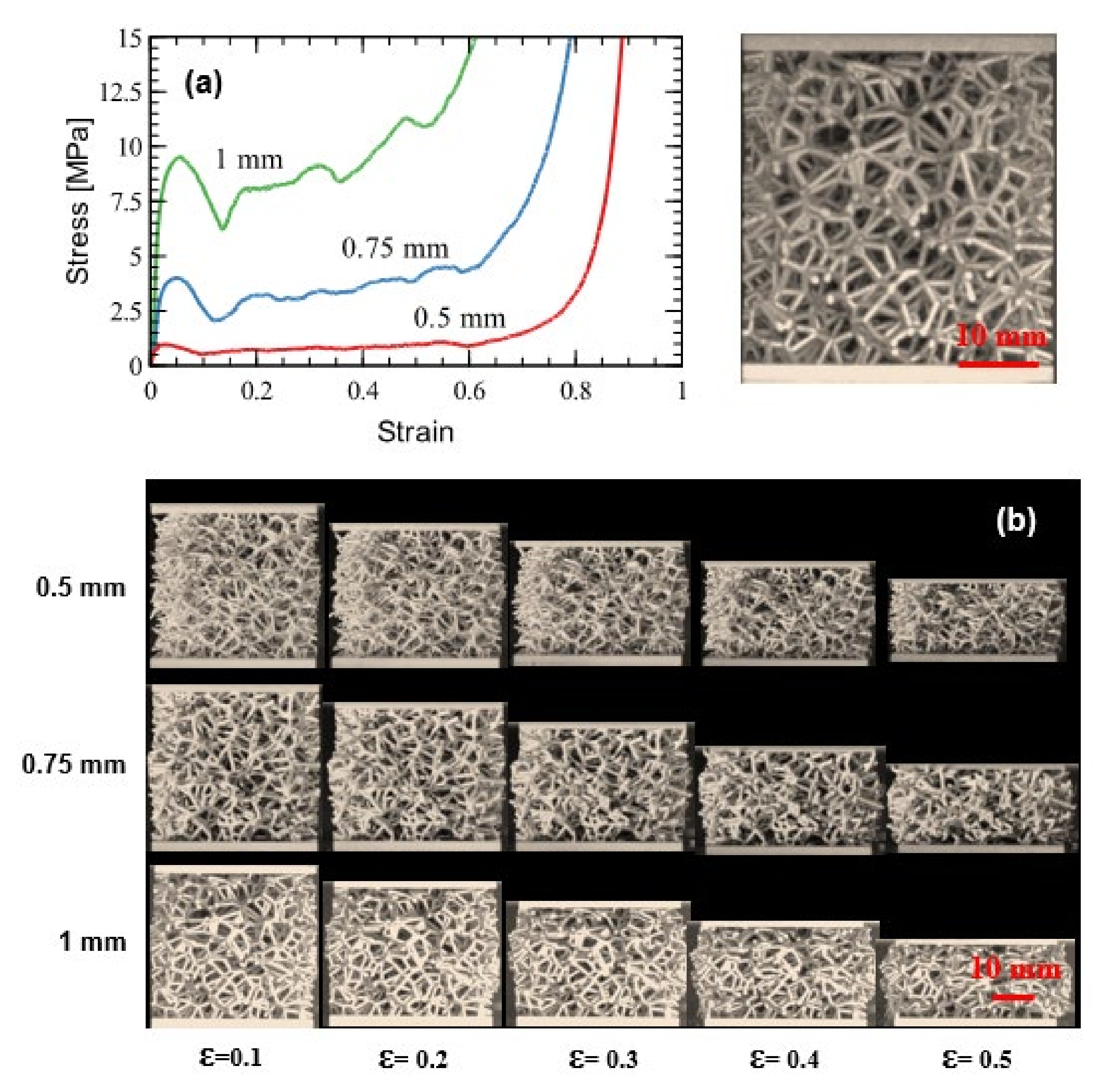




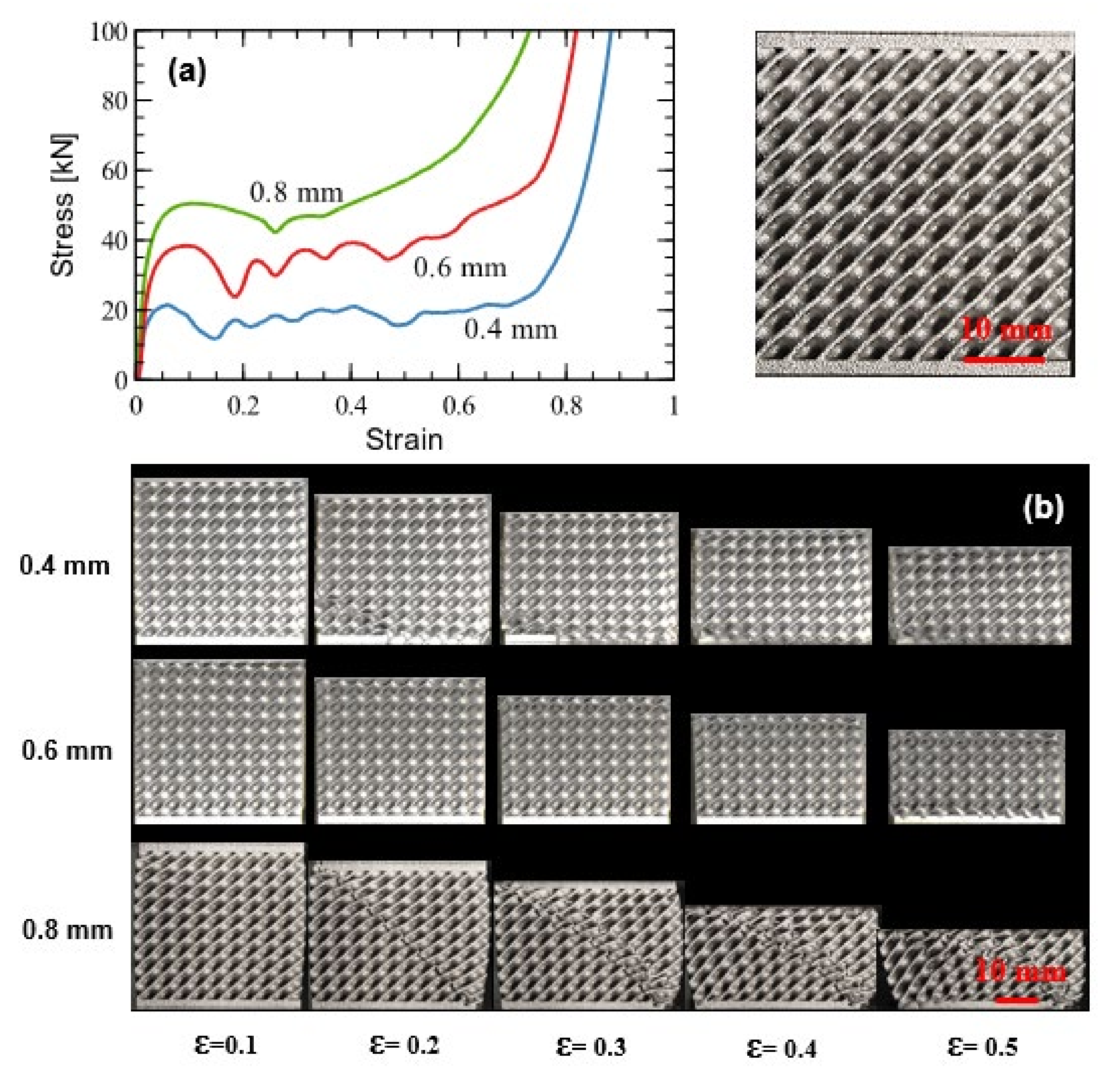

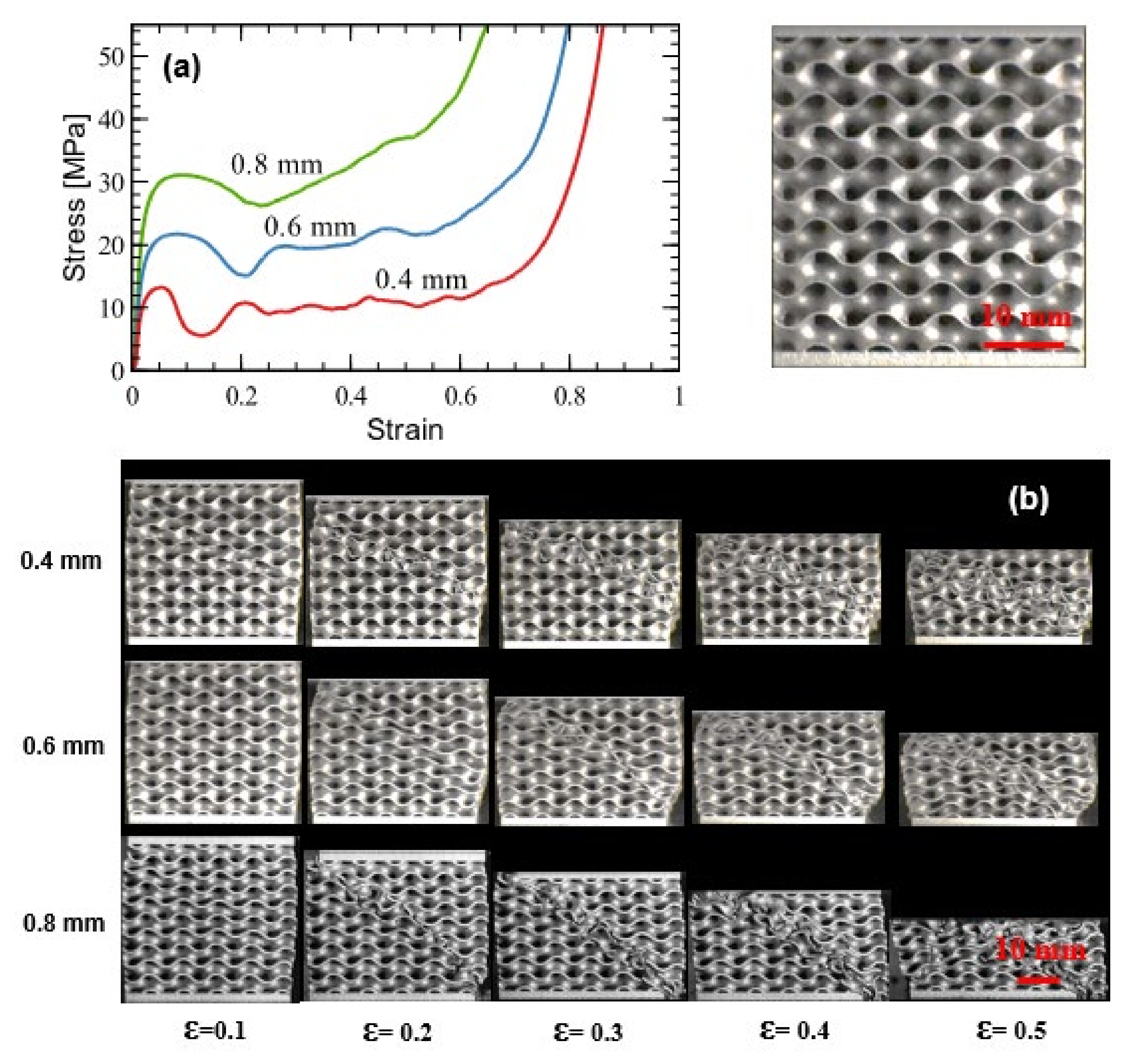

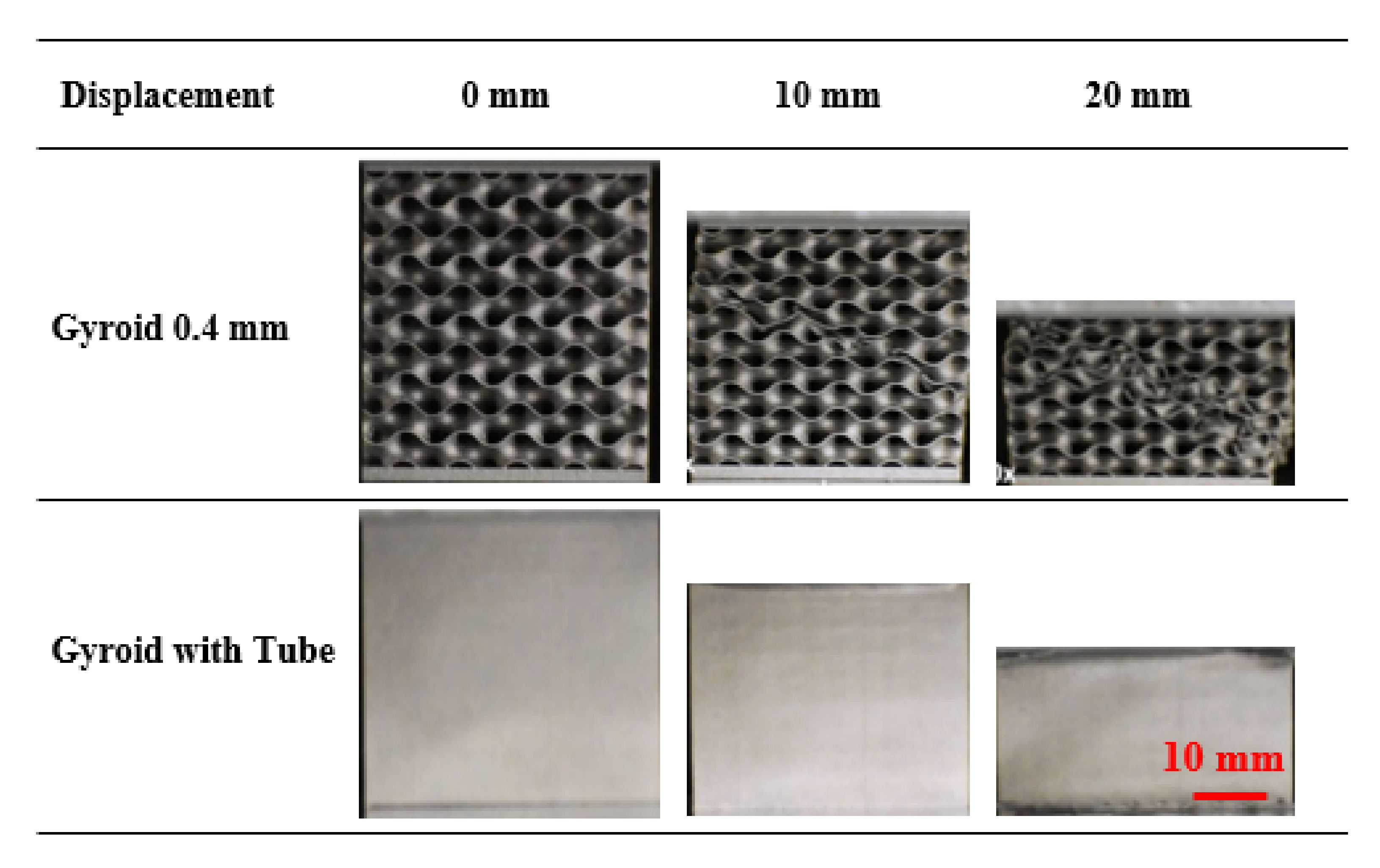
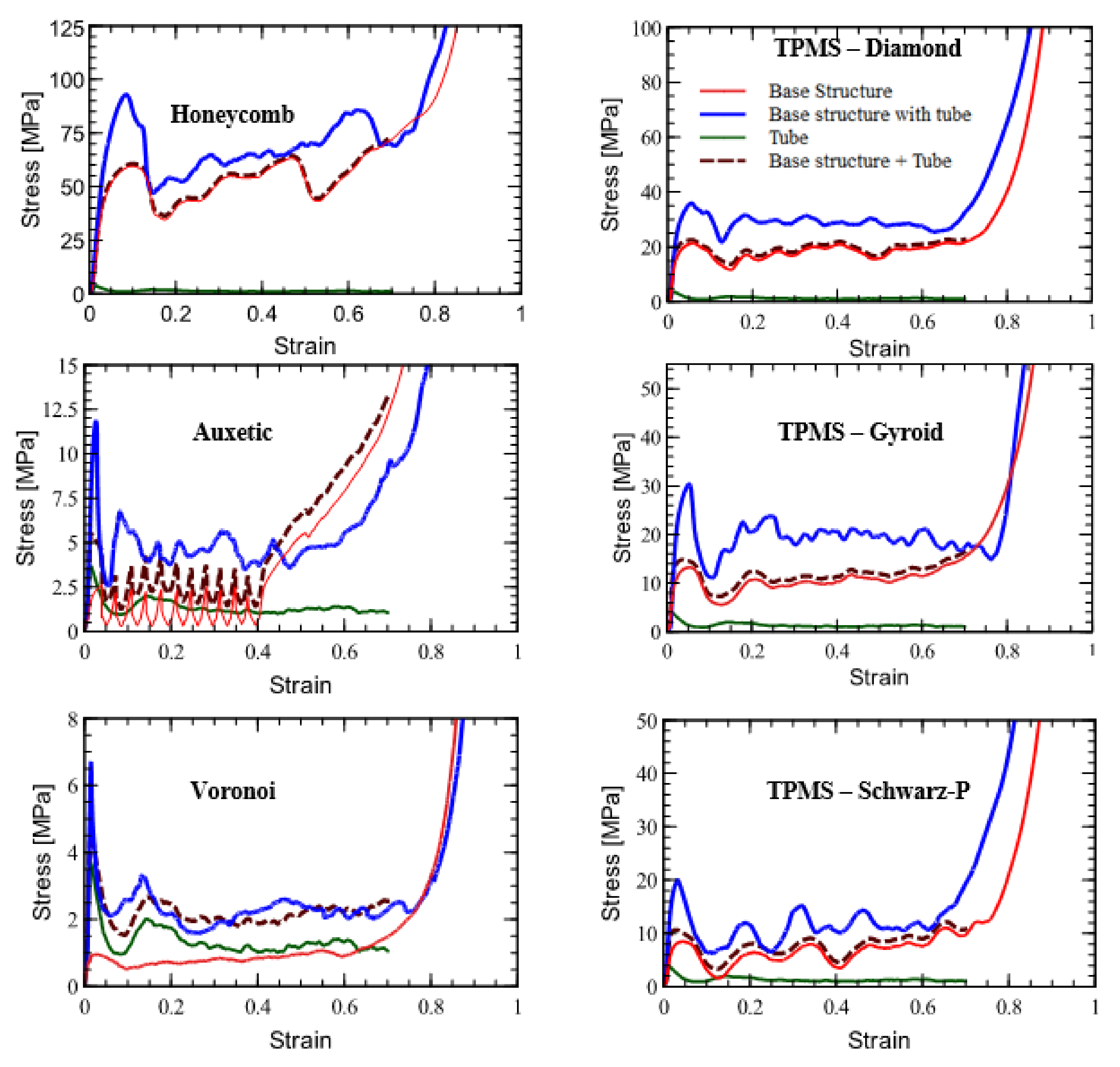
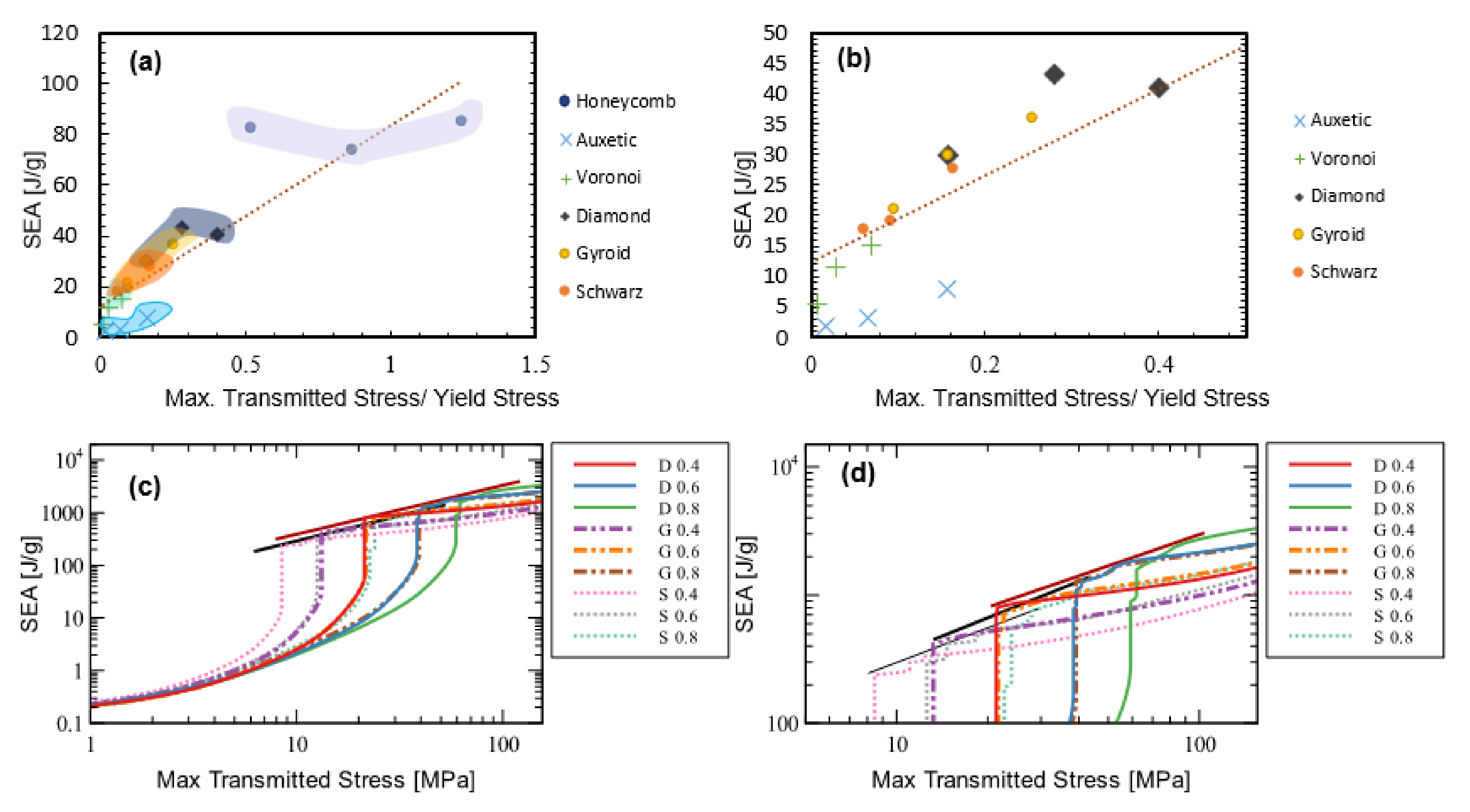

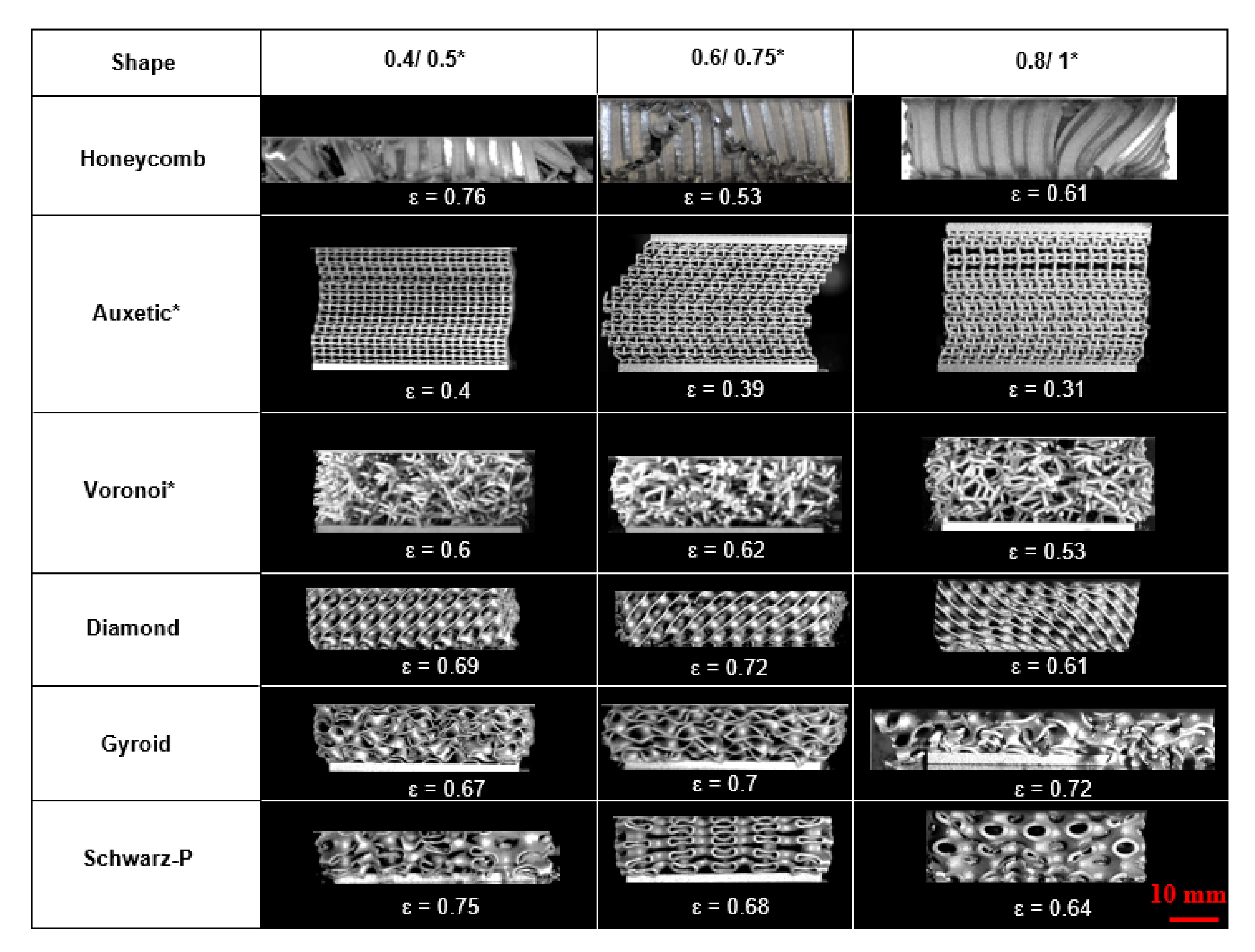
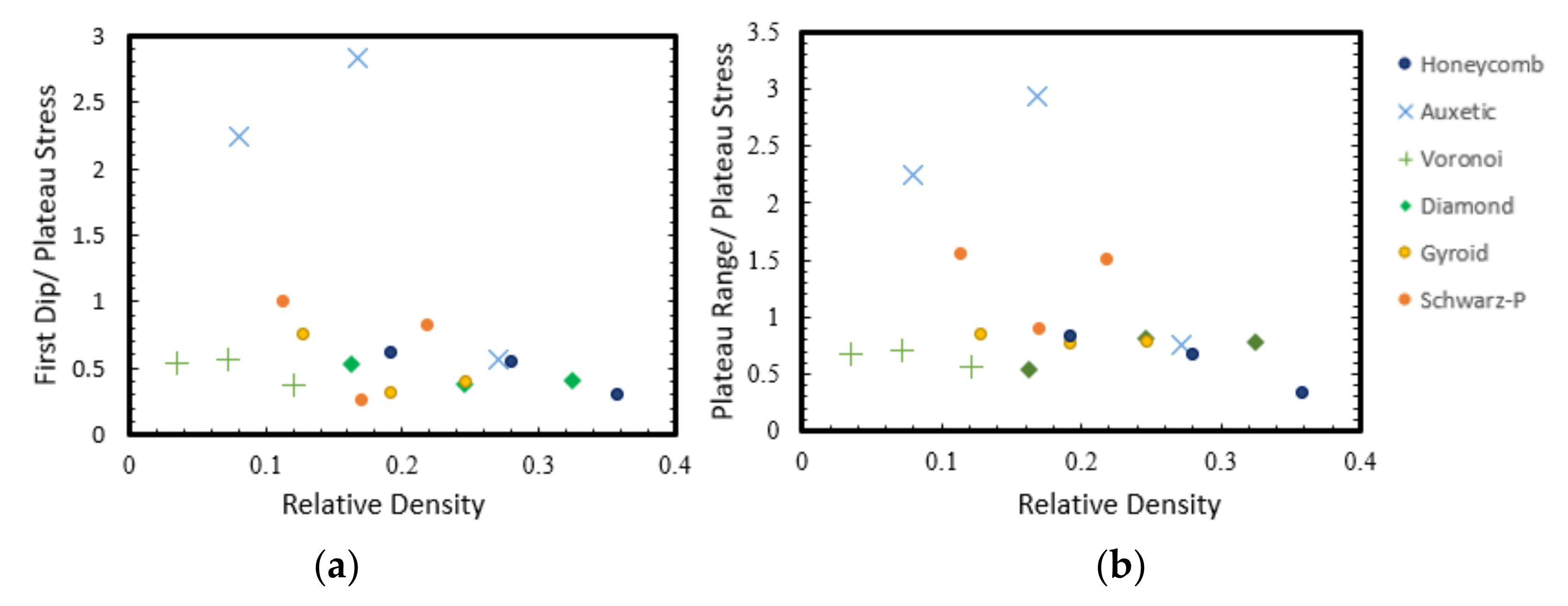

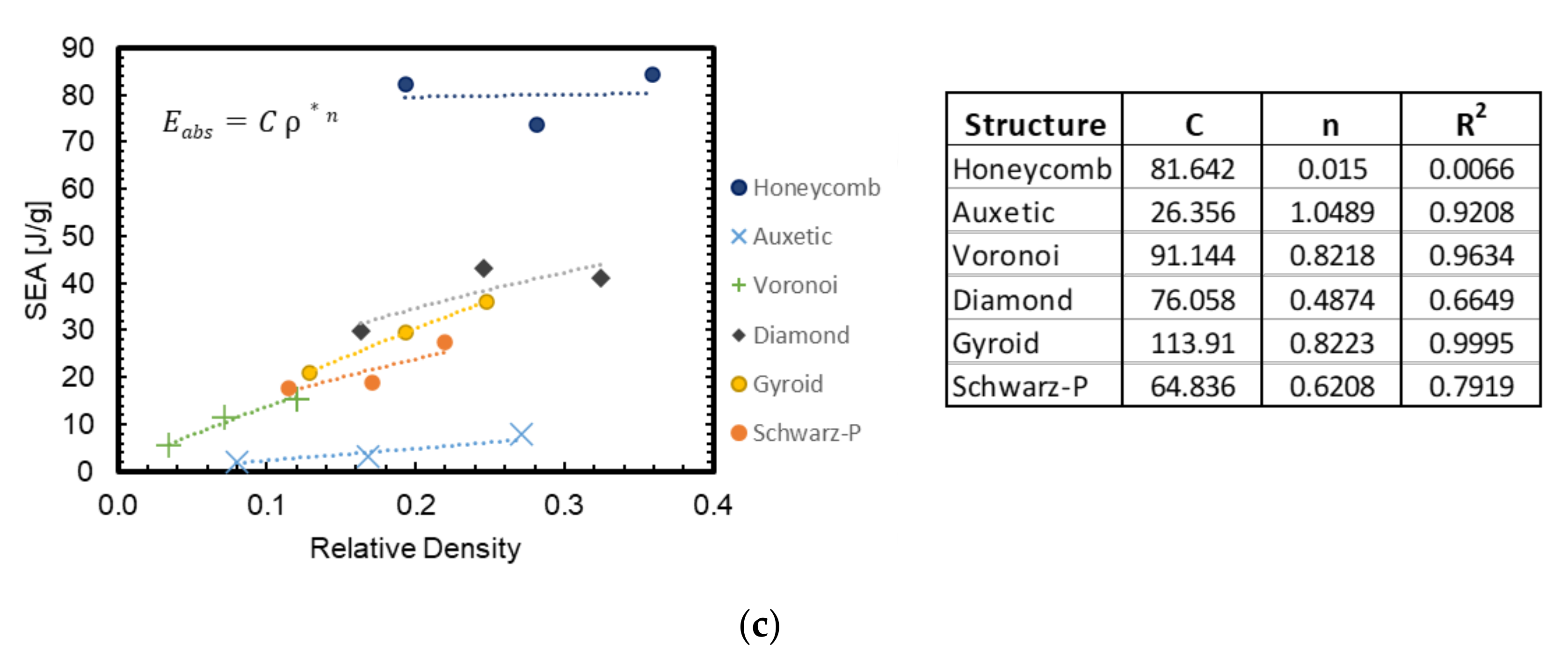
| Lattice Geometry | Process and Material | Relative Density Range (%) | Strain or Displacement Rates |
|---|---|---|---|
| BCC lattice [17] | PBF-LB Stainless Steel 316L | 3.5–13.8 | 0.25 mm/min |
| Uniform and graded thickness BCC lattice [18] | PBF-LB AlSi10Mg | 22 (nominal) | 1.8 mm/min |
| BCC and BCC-Z lattice | PBF-LB Stainless Steel 316L | 3.5–15.9 (nominal) | 0.5 mm/min |
| Cubic, diamond and re-entrant lattice [19] | EBM Ti6Al4V | 13.7–16.6 | 0.2 mm/min |
| Octet truss, rhombic dodecahedron, diamond and dode-medium lattices [20] | PBF-LB Inconel 718 | 15–30 (nominal) | 1 mm/min |
| Pillar octahedral and octahedral lattices [21] | PBF-LB Stainless Steel 316L | 2.9–16.6 | 0.5 mm/min (elastic), 1 mm/min (plateau) |
| Lattice geometry mimicking C15 Laves phase [22] | PBF-LB Al-12Si | 17–37 (nominal) | 0.002 s−1 |
| Hollow micro-lattice [23,24] | Photopolymerization + Nickel coating | ~1.1–32 (nominal) | 1 mm/min |
| TPMS double gyroid [25] | PBF-LB AlSi10Mg | 22 (nominal) | 0.54 mm/min |
| TPMS diamond [26] | PBF-LB AlSi10Mg | 5–15 (nominal) | 0.4 mm/min |
| TPMS diamond [27] | PBF-LB Cu-Cr-Zr copper alloy | 10–20 (nominal) | Quasi-static, rates not specified |
| TPMS P-type and G-type [28] | PBF-LB Stainless Steel 316L | 22.5–36.7 | 0.001 s−1 |
| TPMS P-type, diamond and gyroid [29] | PBF-LB Stainless Steel 316L | 10.4–31.4 | 0.001 s−1 |
| Stacked origami sheet-based materials [30] | PBF-LB Stainless Steel 316L | 18.9–30.5 | 0.001 s−1 |
| Bio-inspired cylindrical surface infilled with lattice struts [31] | PBF-LB AlSi10Mg | NA | 1 mm/min |
| Unit Cell Shape | Thickness (mm) | Nominal Relative Density | Nominal Mass (g) | Measured Relative Density | Measured Mass (g) | % Difference |
|---|---|---|---|---|---|---|
| Honeycomb | 0.4 | 0.20 | 34.74 | 0.19 | 31.94 | −8.05 |
| 0.6 | 0.30 | 51.16 | 0.28 | 48.18 | −5.82 | |
| 0.8 | 0.39 | 66.84 | 0.36 | 63.18 | −5.48 | |
| Auxetic | 0.5 | 0.08 | 40.54 | 0.08 | 44.85 | 10.62 |
| 0.75 | 0.18 | 61.73 | 0.17 | 68.39 | 10.79 | |
| 1 | 0.29 | 88.47 | 0.27 | 102.83 | 16.23 | |
| Voronoi | 0.5 | 0.03 | 23.26 | 0.03 | 23.09 | −0.75 |
| 0.75 | 0.06 | 29.94 | 0.07 | 31.59 | 5.53 | |
| 1 | 0.09 | 38.47 | 0.12 | 42.21 | 9.71 | |
| Diamond | 0.4 | 0.16 | 45.38 | 0.16 | 42.43 | −6.51 |
| 0.6 | 0.25 | 59.56 | 0.25 | 53.85 | −9.58 | |
| 0.8 | 0.33 | 73.48 | 0.32 | 67.74 | −7.81 | |
| Schwarz P | 0.4 | 0.13 | 36.81 | 0.13 | 32.85 | −10.75 |
| 0.6 | 0.19 | 46.59 | 0.19 | 42.43 | −8.93 | |
| 0.8 | 0.26 | 56.42 | 0.25 | 49.89 | −11.57 | |
| Gyroid | 0.4 | 0.11 | 39.28 | 0.11 | 34.85 | −11.29 |
| 0.6 | 0.17 | 50.35 | 0.17 | 45.67 | −9.30 | |
| 0.8 | 0.23 | 61.50 | 0.22 | 56.49 | −8.15 |
| SEA vs. Max Transmitted Stress | Densification Efficiency | Plateau Undulation | Tunability | Overall | |
|---|---|---|---|---|---|
| Honeycomb | 2 | 1 | 1 | 2 | 2 |
| Auxetic lattice | 3 | 3 | 3 | 1 | 3 |
| Voronoi lattice | 3 | 2 | 1 | 1 | 3 |
| Diamond TPMS | 1 | 1 | 1 | 2 | 1 |
| Gyroid TPMS | 1 | 1 | 1 | 1 | 1 |
| Schwarz-P TPMS | 1 | 1 | 2 | 2 | 2 |
Publisher’s Note: MDPI stays neutral with regard to jurisdictional claims in published maps and institutional affiliations. |
© 2022 by the authors. Licensee MDPI, Basel, Switzerland. This article is an open access article distributed under the terms and conditions of the Creative Commons Attribution (CC BY) license (https://creativecommons.org/licenses/by/4.0/).
Share and Cite
Shinde, M.; Ramirez-Chavez, I.E.; Anderson, D.; Fait, J.; Jarrett, M.; Bhate, D. Towards an Ideal Energy Absorber: Relating Failure Mechanisms and Energy Absorption Metrics in Additively Manufactured AlSi10Mg Cellular Structures under Quasistatic Compression. J. Manuf. Mater. Process. 2022, 6, 140. https://doi.org/10.3390/jmmp6060140
Shinde M, Ramirez-Chavez IE, Anderson D, Fait J, Jarrett M, Bhate D. Towards an Ideal Energy Absorber: Relating Failure Mechanisms and Energy Absorption Metrics in Additively Manufactured AlSi10Mg Cellular Structures under Quasistatic Compression. Journal of Manufacturing and Materials Processing. 2022; 6(6):140. https://doi.org/10.3390/jmmp6060140
Chicago/Turabian StyleShinde, Mandar, Irving E. Ramirez-Chavez, Daniel Anderson, Jason Fait, Mark Jarrett, and Dhruv Bhate. 2022. "Towards an Ideal Energy Absorber: Relating Failure Mechanisms and Energy Absorption Metrics in Additively Manufactured AlSi10Mg Cellular Structures under Quasistatic Compression" Journal of Manufacturing and Materials Processing 6, no. 6: 140. https://doi.org/10.3390/jmmp6060140
APA StyleShinde, M., Ramirez-Chavez, I. E., Anderson, D., Fait, J., Jarrett, M., & Bhate, D. (2022). Towards an Ideal Energy Absorber: Relating Failure Mechanisms and Energy Absorption Metrics in Additively Manufactured AlSi10Mg Cellular Structures under Quasistatic Compression. Journal of Manufacturing and Materials Processing, 6(6), 140. https://doi.org/10.3390/jmmp6060140







